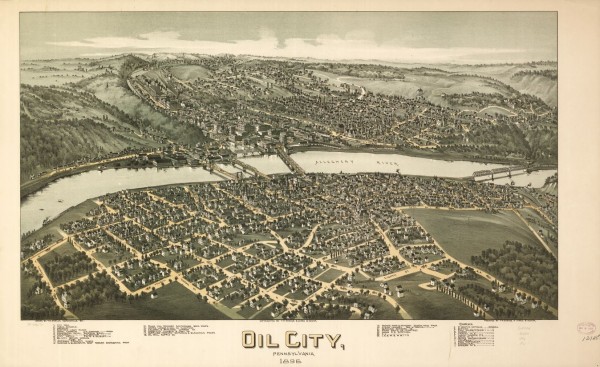This Week in Petroleum History, December 16 – 22
December 17, 1884 – Fighting Oilfield Fires with Cannons –
“Oil fires, like battles, are fought by artillery” proclaimed an article in The Tech, a student newspaper of the Massachusetts Institute of Technology. “A Thunder-Storm in the Oil Country” featured the reporter’s firsthand account of the problem of lightning strikes in America’s oilfields.
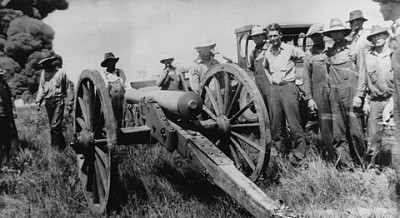
Lightning strikes in the Great Plains resulted in oil tank fires — and the need to keep cannons nearby to shoot holes to drain the tanks. Photo courtesy Kansas Oil Museum. El Dorado, Kansas.
The MIT article not only reported on the fiery results of a lightning strike, but also the practice of using Civil War cannons to fight such conflagrations. Shooting a cannonball into the base of a burning tank allowed oil to drain safely into a holding pit until the fire died out. “Small cannons throwing a three-inch solid shot are kept at various stations throughout the region for this purpose,” the article noted.
Learn more in Oilfield Artillery fights Fires.
December 17, 1903 – Natural Gas contributes to Aviation History
A handmade engine burning 50-octane gasoline for boat engines powered Wilbur and Orville Wright’s historic 59-second flight into aviation history at Kitty Hawk, North Carolina. The brothers’ “mechanician,” Charlie Taylor, fabricated the 150-pound, 13-horsepower engine in their Dayton, Ohio, workshop.
The workshop included a single-cylinder, three-horsepower natural gas-powered engine that drove an overhead shaft and belts that turned a lathe, drill press — and an early, rudimentary wind tunnel. Natural gas was piped from a field in Mercer County, about 50 miles northwest.
Learn about advances in high-octane aviation fuel in Flight of the Woolaroc.
December 17, 1910 – Petrolia field brings Helium to North Texas
Although traces of oil had been found as early as 1904 in Clay County, Texas, a 1910 gusher revealed an oilfield soon named after one of the earliest boomtowns, Petrolia, Pennsylvania. The discovery well southeast of Wichita Falls produced 700 barrels of oil a day from a depth of 1,600 feet. The field’s annual oil production peaked in 1914 as discoveries at Electra and Burkburnett overshadowed Petrolia.

Helium derived from natural gas filled the U.S. Navy’s first helium airship, the Shenandoah, built in 1923 and here emerging from its Lakehurst, N.J., hangar.
However, the Petrolia natural gas contained .1 percent helium, a strategic resource at the time. (see Kansas “Wind Gas” Well). “In 1915 the United States Army built the first helium extraction plant in the country at Petrolia, and for several years the field was the sole source of helium for the country,” notes the Texas State Historical Association (TSHA).
December 18, 1929 – California Oil Boom in Venice
The Ohio Oil Company completed a wildcat well in Venice, California, on the Marina Peninsula, that produced 3,000 barrels of oil a day from a depth of 6,200 feet. The Ohio Oil Company, which would become Marathon Oil of Ohio, had received a zoning variance to drill within the city limits. The Venice oilfield discovery launched another California drilling boom similar to Signal Hill eight years earlier.
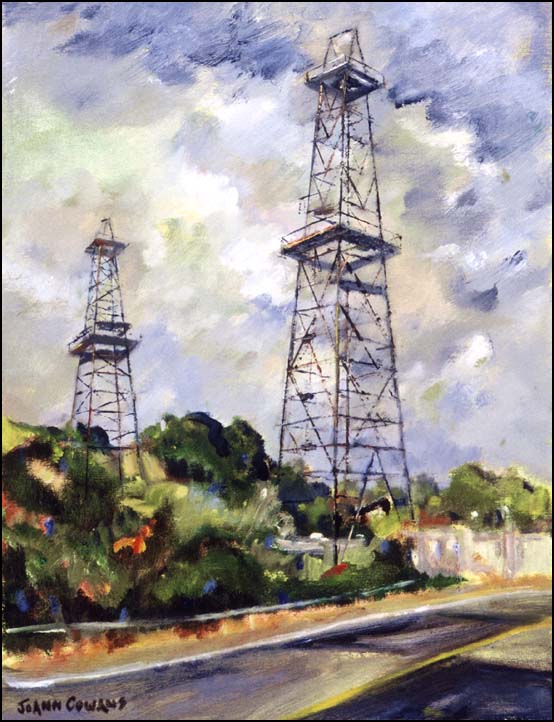
California artist JoAnn Cowans painted scenes of derricks in the Venice and Brea oilfields before they were dismantled.
“The discovery of oil at the beginning of the Depression, at a time when there was little disposable income for Venice’s amusement industry, brought the possibilities of untold wealth for the community,” notes the Vince History Site. In January 1930, a crowd of 2,000 met with city officials and demanded re-zoning to allow oil drilling.
December 18, 1934 – Hunt Oil Company founded in Texas
Hunt Oil Company, among the largest privately held U.S. petroleum companies, incorporated in Delaware and opened an office in Tyler, Texas. Four years earlier, Haroldson Lafayette “H.L.” Hunt had acquired the Daisy Bradford No. 3 well and other East Texas oilfield properties from C. Marion “Dad” Joiner.
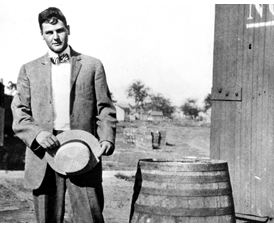
H.L. Hunt’s oil career began in Arkansas and East Texas and spanned much of the industry’s history, notes Hunt Oil Company. Photo circa 1911.
“H.L. Hunt bought the lease out ‘lock, stock and barrel,’ financing the deal with a first-of-its-kind agreement to make payments from future ‘down-the-hole’ production,” according to Hunt Energy. “The Bradford No. 3 turned out to be the discovery well of the great East Texas oilfield, which, at the time, was the greatest oilfield in the world.”
Hunt Oil moved its headquarters to Dallas in 1937 and drilled the first Alabama oil well in 1944. The company began offshore exploration in 1958 with leases in the Gulf of Mexico.
December 19, 1924 – Government debates Oil Conservation
Declaring “the supremacy of nations may be determined by the possession of available petroleum and its products,” President Calvin Coolidge appointed a Federal Oil Conservation Board to appraise oil policies and promote conservation of the strategic resource.
With Navy ships converting to oil from coal (see Petroleum and Sea Power), the resulting crude oil shortages in 1919 and 1920 gave credibility to predictions of domestic supplies running out within a decade, according to the U.S. Geological Survey (USGS). Debates about oil conservation continued during establishment of President Franklin Roosevelt’s National Industrial Recovery Act in 1933 — and its rejection as unconstitutional by the Supreme Court in 1935.
December 20, 1951 – Oil discovered in Washington State
A short-lived oil discovery in Washington foretold the state’s production future. The Hawksworth Gas and Oil Development Company exploratory well was completed near Ocean City, producing 35 barrels of oil a day from a depth of 3,700 feet before being abandoned as noncommercial. In 1967, Sunshine Mining Company deepened the well to more than 4,500 feet, but with only minor shows of oil, it was shut in again.

Washington’s 1951 lone oil well yielded a total of just 12,500 barrels of oil over a decade of production.
By 2010, of the 600 exploratory wells drilled in 24 Washington counties, only one produced commercial quantities of oil — a 1959 well completed by Sunshine Mining Company 600 yards north of the failed Hawksworth site. That well, Washington’s only commercial producer, was capped in 1961.
“The geology is too broken up and it does not have the kind of sedimentary basins they have off the coast of California,” explained a Washington Natural Resources geologist in 1997 (also see California Oil Seeps).
December 21, 1842 – Birth of an Oil Town “Bird’s-Eye View” Artist
Panoramic map artist Thaddeus Mortimer Fowler was born in Lowell, Massachusetts. Following the fortunes of America’s early petroleum industry, he would produce hundreds of unique maps of the earliest oilfield towns of Pennsylvania, West Virginia, Oklahoma and Texas.
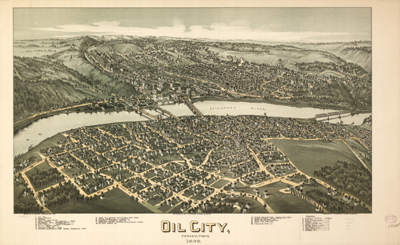
Oil City, Pennsylvania, prospered soon after America’s first commercial oil discovery in 1859 at nearby Titusville. T.M. Fowler 1896 map courtesy Library of Congress.
Fowler was one of the most prolific of the bird’s-eye view artists who crisscrossed the country during the latter three decades of the 19th century and early 20th century, according to the Amon Carter Museum of American Art, Fort Worth, Texas. Seemingly drawn from great heights, the views were made with skillful cartographic techniques.

More than 400 Thaddeus Fowler panoramas have been identified by the Library of Congress, including this detail of the booming oil town of Sistersville, West Virginia, published in 1896.
Fowler featured many of Pennsylvania’s earliest oilfield towns, including Titusville and Oil City — and the booming community of Sistersville in the new state of West Virginia. He traveled through Oklahoma and Texas in 1890 and 1891 similarly documenting Bartlesville, Tulsa, and Wichita Falls.
Learn more in Oil Town “Aero Views.”
December 21, 1909 – Arctic Explorer turned Oil Promoter
One year after making widely accepted claims to have reached the North Pole, a special commission at the University of Copenhagen ruled explorer Dr. Frederick Cook had no evidence he reached the pole during his arctic journey. Cook had already become a celebrity when Admiral Robert E. Peary achieved that milestone in April 1909.

Despite the commission’s ruling, Cook used his fame to promote fraudulent oil exploration ventures in Texas, Wyoming, Arkansas, and other states. In 1923. he was convicted of mail fraud and served prison time in Leavenworth, Kansas, until pardoned by President Franklin D. Roosevelt in 1940.
Learn more in Arctic Explorer turned Oil Promoter.
December 22, 1875 – Grant seeks Asphalt for Pennsylvania Avenue
President Ulysses S. Grant convinced Congress to repave Pennsylvania Avenue’s badly deteriorated plank boards with asphalt. Grant delivered to Congress a “Report of the Commissioners Created by the Act Authorizing the Repavement of Pennsylvania Avenue.”
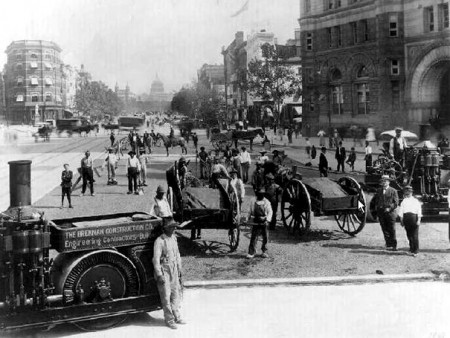
Pennsylvania Avenue was first paved with Trinidad bitumen in 1876. Above, asphalt distilled from petroleum in 1907 repaved the road to the Capitol.
The project would cover 54,000 square yards. “Brooms, lutes, squeegees and tampers were used in what was a highly labor-intensive process.” With work completed in the spring of 1877, the asphalt – obtained from a naturally occurring bitumen lake found on the island of Trinidad – would last more than 10 years.
In 1907, the road to the Capitol was repaved again with a superior asphalt made with petroleum from U.S. oilfields. By 2005, the Federal Highway Administration reported that more than 2.6 million miles of America’s roads were paved.
Learn more in Asphalt Paves the Way.
December 22, 1903 – Carl Baker patents Cable-Tool Bit
Reuben Carlton “Carl” Baker of Coalinga, California, patented an innovative cable-tool drill bit in 1903 after founding the Coalinga Oil Company.
“While drilling around Coalinga, Baker encountered hard rock layers that made it difficult to get casing down a freshly drilled hole,” noted a Baker-Hughes historian in 2007. “To solve the problem, he developed an offset bit for cable-tool drilling that enabled him to drill a hole larger than the casing.”
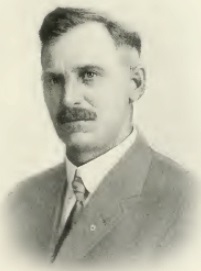
Baker Tools Company founder R.C. “Carl” Baker in 1919.
Coalinga would become a petroleum boom town thanks to Baker’s leadership, according to the town’s museum. He helped establish several oil companies, a bank, and the local power company. After drilling wells in the Kern River oilfield, he added another innovation in 1907 by patenting the Baker Casing Shoe, a device ensuring uninterrupted flow of oil through the well.
By 1913 Baker organized the Baker Casing Shoe Company (renamed Baker Tools two years later). He opened his first manufacturing plant in Coalinga in a building — today home to the R.C. Baker Museum. Baker never advanced beyond the third grade, but “possessed an incredible understanding of mechanical and hydraulic systems.”
Learn more in Carl Baker and Howard Hughes.
December 22, 1975 – Strategic Petroleum Reserve established
President Gerald R. Ford established the U.S. Strategic Petroleum Reserve by signing the Energy Policy and Conservation Act of 1975. With a capacity of 713.5 million barrels of oil in 2018, the Strategic Petroleum Reserve was the largest stockpile of government-owned emergency oil in the world. SPR storage sites include five salt domes on the Gulf Coast. In addition to SPR, the Department of Energy maintains a Northeast Home Heating Oil Reserve of one million barrels and a one million barrel supply of gasoline.
_______________________
Recommended Reading: Trek of the Oil Finders: A History of Exploration for Petroleum (1975); The Wright Brothers (2016); Helium: Its Creation, Discovery, History, Production, Properties and Uses (2022); Black Gold, the Artwork of JoAnn Cowans
(2009); The Three Families of H. L. Hunt: The True Story of the Three Wives, Fifteen Children, Countless Millions, and Troubled Legacy of the Richest Man in America
(1989); Bird’s Eye Views: Historic Lithographs of North American Cities
(1998); Down the Asphalt Path: The Automobile and the American City
(1994); History of Oil Well Drilling
(2007). Your Amazon purchase benefits the American Oil & Gas Historical Society. As an Amazon Associate, AOGHS earns a commission from qualifying purchases.
_______________________
The American Oil & Gas Historical Society (AOGHS) preserves U.S. petroleum history. Please become an AOGHS annual supporter and help maintain this energy education website and expand historical research. For more information, contact bawells@aoghs.org. Copyright © 2024 Bruce A. Wells. All rights reserved.




